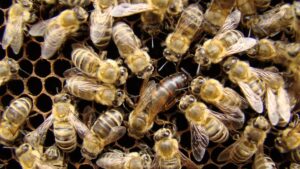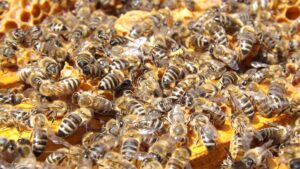As an apiologist, I am infinitely fascinated with honey bees. I share my enthusiasm about honey bees with others at every opportunity. People are naturally curious about bees, but many know very little about them. Most people are surprised when I tell them that the honey bee (Apis mellifera) is not native to North America. They were introduced by early European settlers in the early 1600s and very quickly became an essential component of agriculture as it expanded throughout North America.
There are many insects and other animals that are considered pollinators, but only the honey bee can be managed to provide the numbers needed for commercial-scale agriculture. Today, honey bees are responsible for pollinating many of the fruits, nuts and vegetables that are necessary for a healthy diet. So essential are honey bees that commercial beekeepers are paid to follow the bloom from almonds in California, to apples in various states, to low bush blueberries in Maine and many other crops by transporting up to 1.5 million hives each year. In Alberta, Canada, Bayer is the largest user of honey bees for the pollination of canola grown for seed.
A variety of honey bee pests, parasites, and pathogens threaten the health and survival of honey bee colonies. In addition, because commercial honey bee populations are managed, the total number of colonies is artificially high, and often exceeds seasonably-available forage which provides nectar and pollen to satisfy the nutritional needs of the bees. These factors, along with other stressors, including extreme weather events, reductions in forage areas, genetic characteristics and, in some cases, colony management practices, are having a dramatic negative impact on honey bee health. Therefore, beekeepers are having difficulties keeping colonies alive, and this is very frustrating and financially devastating for them.
One of the most important threats to honey bee health is the Varroa mite (Varroa destructor), an exotic parasite introduced to North America in the mid-1980s. This mite is the vampire of the bee world because it feeds by sucking the blood of honey bees and reproduces on bee brood. Serious bee diseases are also vectored by the mite, which makes Varroa and the associated pathogens a very lethal mix. In the last half of 2012, several conditions during the year lead me to make the prediction that we could be entering a period of colony losses, primarily from Varroa, either directly or indirectly. These conditions included better colony survival over the winter of 2011/2012 and an early spring in 2012 which provided pollen and nectar earlier in the year than is usual, resulting in rapid colony growth and development. Unfortunately, strong colonies and long brood rearing seasons are excellent for Varroa population increases as well, and reports of higher mite counts started coming in during August which confirmed this was the case. Therefore, all indications were that colony losses could be severe in the fall of 2012 and over winter into the spring of 2013. This forecast appears to be coming true, so I expect 2013 will be a difficult year of recovery and rebuilding bee stocks.
Beekeepers do not have many effective tools for managing Varroa mite. Therefore, efforts to find a solution are being ramped up, and hopefully research will provide new, effective tools and strategies for monitoring and managing the complex mix of honey bee problems in the near future. So far, advances in biotechnology and seed treatments have helped transform the productivity of our farms and have reduced the risk of pollinator exposure compared to the alternative of repeated broadcast applications. Plant protection measures and pollination are necessary parts of a dynamic agro-ecosystem, and it is clear that apiculture and crop production agriculture must, and can, coexist.
Bayer CropScience is looking forward to continuing its research efforts to promote and protect honey bees. In 2013, Bayer will break ground on a new Bee Care Center at our headquarters in Research Triangle Park, NC. This center is dedicated to contributing to the solution to honey bee health and other bee pollinators, and complements another facility which opened in 2012 at our global headquarters in Germany. The common purpose of these two centers is to focus our internal resources, while collaborating with other scientists and institutions, to help ensure that honey bees, and bee pollinators in general, remain available to continue the vital role of pollinating our food supply. The solution to the challenges to honey bee health will not come easy, but it is clear that when we all work together to understand the many factors affecting bee health and how to provide the needs of the bees, we will be able to ensure the commercial availability of honey bees for a sustainable agriculture system that will help feed the growing world population.
Dick Rogers, apiologist, Bayer Bee Care Center, Bayer CropScience LP












